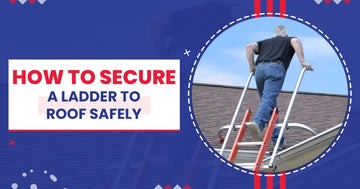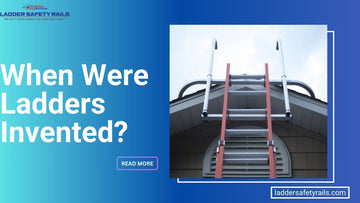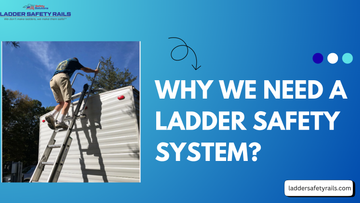
We sometimes need to work on the roof for cleaning, repairing shingles, or installing rooftop equipment. But getting on the roof can be daunting without the right precautions and techniques. Having a stable and secure ladder setup is of paramount importance.
A ladder that's improperly secured can lead to accidents, injuries, and property damage. Failure to properly secure a ladder can result in numerous fatalities. As stated in OHS In 2020, 161 workers suffered fatal injuries from using ladders, per the Bureau of Labor Statistics.
And in the fiscal year 2022, violations involving ladders in construction ranked fourth in OSHA’s top 10 most frequently cited standards, with 2,143 violations found.
Therefore, understanding the proper techniques for securing a ladder to a roof is essential. To ensure a safe and successful experience we will help you walk through the step-by-step process of how to secure the ladder to a roof safely.
What is the best way to secure a ladder to the roof?
The best way to effectively secure a ladder to the roof involves a careful combination of correct ladder placement, the utilization of stabilizers, and, above all, adhering to the essential safety protocols.
While doing this, choose a clear, calm day. Working in challenging weather conditions such as strong winds or heavy rain can jeopardize your safety and potentially hamper the quality of your work.
While we are ready to secure a ladder to the roof, not only consider the top but strengthening the base of the ladder is crucial too. Ensure the ladder is in good condition.
Here are some basic steps to secure a ladder to the roof:
Locate a Good Roof Spot to place the ladder
Identify a portion on the roof that is architecturally strong. The spot should be able to support the weight of the ladder and the person climbing on it. Avoid any area that has visible damage or looks decayed.
Put the ladder in the right spot
Always look for a flat and sturdy area on the ground where a ladder can be positioned. Soft and uneven ground should be avoided. Also, consider the slope and pitch of the roof while placing the ladder. The ladder should not be placed against a steep slope.
Make the ladder steady from the bottom
Make sure that the base of the ladder is firmly placed at the bottom. If the ladder has adjustable feet, use them for better stability. Brace or tie the ladder at the bottom. Use an anchor in the ground if there isn't a structure to tie off to.
Go up the ladder, attach to the roof
Before climbing the ladder, ensure that there is no wobbling or instability. Choose an appropriate angle while setting the ladder to the roof. Place the ladder's top against a sturdy surface that can support the load.
How Do You Keep Ladders from Slipping?
Preventing ladders from slipping is paramount for safety while working at elevated heights. Many ladders are designed with rubber feet to prevent slipping. Anti-slip resistant pads can also be used to keep ladders from slipping.
Avoid using the ladder if the ground is slippery or wet. Even if the ladder has to be used, try slip-resistant features that enhance traction and reduce the risk of any unintended movement.
Ladder stabilizers or standoffs are important attachments that give a broader and more stable top support, reducing the possibility of the ladder slipping.
Make sure the ladder is adequately supported when leaning it against a wall or other structure to avoid slipping. If feasible, it is beneficial to attach the top of the ladder to a solid anchor point.
Is It Safe to Put a Ladder on the Roof?
Yes, it can be safe to put a ladder on the roof, but it's essential to follow proper safety protocols to minimize risks. Placing a ladder on the roof can be necessary for tasks like inspecting the roof or performing maintenance.
Wear appropriate personal protective equipment, including non-slip shoes, gloves, and a safety harness if necessary.
How to Stabilize a Ladder on a Roof?
Safety hooks make it easier to stabilize the ladder at the top. They prevent the ladder from falling sideways and minimize the chances of the ladder base sliding from the wall. Here are some steps to consider while stabilizing the ladder on the roof.
Step 1: Check the ladder- Choose the right ladder for the job. Extension ladders are commonly used for accessing roofs. Make sure the ladder is in good condition and appropriate for your weight and the task. Also, be sure to check the ladder for wear and any signs of tears.
Step 2: Set the base- When stabilizing a ladder, always work from the bottom to move upwards. If the base of the ladder is faulty, it is not a secure start. Make sure to place the ladder on a firm, level surface. Clean the surroundings if necessary and anchor the ladder firmly.
Step 3: Settle the top– One can prevent a ladder from falling back by securely fastening it to the roof. Use something robust to hold the ladder in place and fasten it to the top. This might be steel or rope, but a ladder stabilizer system is preferable to ensure ladder safety while accessing the roof.
Which is the safest device to use while climbing?
Once the ladder is set with a sturdy base and well-anchored on the roof, it is ready to climb on. Proper shoes, that are slip resistant, should be worn while climbing the ladder. One of the safest devices to use while climbing a ladder is a ladder stabilizer or standoff.
A ladder stabilizer is an accessory that attaches to the top of the ladder and provides additional support and stability. It helps prevent the ladder from slipping sideways and damaging the surface it's leaning against, such as a wall, gutters or roof.
Ladder Safety Rails- When used on a pitched roof, flat roof, or vertical surface, ladder safety rails help to stabilize the ladder. The unique extendable handrails offer sturdy support for a smooth transition to an elevated platform and a secure descent from that height.

Soft-Touch Bumpers- These soft bumpers are innovative safety features designed to prevent surface damage and provide exceptional grip and stability when a ladder is in contact with walls, doors, or other structures. These bumpers are typically made of non-slip material like rubber or durable polymer and often affixed to ladder stabilizers and standoffs.

Why Choose Ladder Safety Rails to Buy Ladder Stabilizers?
There are several compelling reasons why Ladder Safety Rails is the best choice for purchasing ladder stabilizers. Our products are designed with a focus on safety and quality, ensuring stability and preventing ladder accidents.
The unique design of the Ladder Safety Rails was developed to fit various ladder types and sizes, catering to different needs. With a user-friendly website and excellent customer service, it makes the buying process seamless.
Buy the secure ladder rails and prevent accidents!
FAQs
How to Secure a Ladder on a Roof?
To secure a ladder on a roof, first ensure the ladder is long enough to extend at least three feet beyond the roof edge. Place the ladder at an appropriate angle, following the 4-to-1 rule for stability.
Use ladder stabilizers or hooks to securely attach the ladder to the roof peak or eaves, preventing it from slipping sideways. If possible, have someone hold the ladder's base.
Maintain three points of contact while ascending and secure the ladder with ropes or straps for added stability. Prioritize safety, and only attempt this if you're experienced and confident in ladder use.
How do you tie a ladder safely?
To safely tie a ladder, follow these steps. Place the ladder on a stable surface, and extend it beyond the intended work area by about 3 feet. Secure the ladder's top with a rope or bungee cord and attach it to a sturdy anchor point like a roof beam or railing.
Avoid using knots that may be difficult to untie. Additionally, use ladder stabilizers or hooks for added security. Regularly check the knots and attachments for tightness. Remember, proper securing of the ladder is crucial to prevent accidents and ensure your safety while working at height.
How do you stop a ladder from slipping?
To prevent a ladder from slipping, ensure its placed on a stable, level surface. When working on soft ground, it is important to utilize a stable base or ladder leveler. Consider anti-slip rubber feet for added traction.
For extra security, have someone hold the ladder's base while you climb, or use ladder stabilizers/anchors. Additionally, make sure the ladder angle is correct following the 4-to-1 rule. These precautions will reduce the risk of ladder slipping and enhance your safety while working at height.




